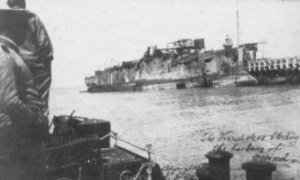
Back Second raid sur Ostende French Második oostendei rajtaütés Hungarian Secondo raid di Ostenda Italian Tweede aanval op de haven van Oostende Dutch Второй рейд на Остенде Russian Operation VS Swedish İkinci Ostend Baskını Turkish
| Second Ostend Raid | |||||||
|---|---|---|---|---|---|---|---|
| Part of North Sea Operations, First World War | |||||||
 Postwar wreck of HMS Vindictive at Ostend | |||||||
| |||||||
| Belligerents | |||||||
|
|
| ||||||
| Commanders and leaders | |||||||
|
|
| ||||||
| Strength | |||||||
|
1 blockship 4 monitors 8 destroyers 5 motor launches Aerial support | Shore defences | ||||||
| Casualties and losses | |||||||
|
1 motor launch sunk 8 dead 10 missing 29 wounded |
3 killed 8 wounded | ||||||
The Second Ostend Raid (officially known as Operation VS) was the later of two failed attempts made during the spring of 1918 by the United Kingdom's Royal Navy to block the channels leading to the Belgian port of Ostend as a part of its conflict with the German Empire during World War I. Due to the significant strategic advantages conferred by the Belgian ports, the Imperial German Navy had used Ostend as a base for the U-boat campaign during the Battle of the Atlantic since 1915.
A successful blockade of these bases would have forced German submarines to operate out of more distant ports, such as Wilhelmshaven, on the German coast. This would expose them for longer to Allied countermeasures and reduce the time they could spend raiding. The ports of Ostend and Zeebrugge (partially blocked in the Zeebrugge Raid three weeks previously) provided sea access via canals for the major inland port of Bruges. Bruges was used as a base for small warships and submarines. As it was 6 mi (5.2 nmi; 9.7 km) inland, it was immune to most naval artillery fire and coastal raids, providing a safe harbour for training and repair.
The First Ostend Raid on 23 April 1918 was largely a failure, the blockships grounded too far from the channels to obstruct them. The second attempt also failed, due to heavy German resistance and British navigational difficulties in poor weather. In anticipation of a raid, the Germans had removed the navigation buoys and without them the British had difficulty finding the narrow channel into the harbour in poor weather. When they did discover the entrance, German resistance proved too strong for the operation to be completed as originally planned: the obsolete cruiser HMS Vindictive was sunk, but only partially blocked the channel.
Despite its failure, the raid was presented in Britain as a courageous and daring gamble that came close to success. Three Victoria Crosses and numerous other gallantry medals were awarded to sailors who participated in the operation. British forces had moderate casualties in the raid, while German losses were minimal.